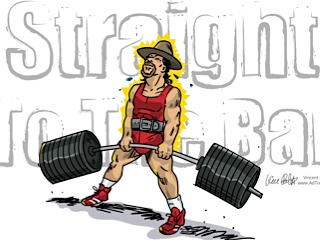The bottom, or bottom-up squat (sometimes called ‘dead stop squat‘) is simply a squat performed starting from the lowest position. This is usually done in a power rack from pins that mean your thighs are horizontal.
How does this change things? It affects the squat in a couple of ways, which may or may not be appropriate for your training. Personally I love them. The differences :
- There’s no walk-out. In this way it’s like having your own monolift. Of course the walk-out itself is a very worthwhile exercise, and there’s nothing stopping you from doing them separately.
- Starting from the bottom eliminates the stretch relex. There’s no chance to build up elastic potential energy (thanks John) for the trip up, so you’re starting cold. This can make them a little tougher, and is the main reason I like them.
Remember that the stretch reflex can be very useful at times. Bottom squats are great things, but not always appropriate. If you’re training to be explosive from a dead stop (as in Olympic Lifting), they might be worth giving a go. On the other hand, if your chosen sport keeps you moving around the majority of the time, the usual varieties of top-down squats may be more beneficial. Personally, as I enjoy weight training purely for fun, I employ both bottom-up and top-down methods. It’s up to you.
More information, references and other fun things to try
The picture is from Bud Jeffries’ 1,000lb bottom squat. His challenge for anyone to duplicate this is ongoing.
This thread on the Go Heavy forums put me onto an article in Powerlifting USA, by Kenny Croxdale and Tom Morris. Excellent reading.
If you’ve stopped doing pistol squats because they’re no longer challenging enough, try these. John Davies has found a way to eliminate the stretch reflex in the basic pistol, and turned it into an unholy beast.












0 Comments